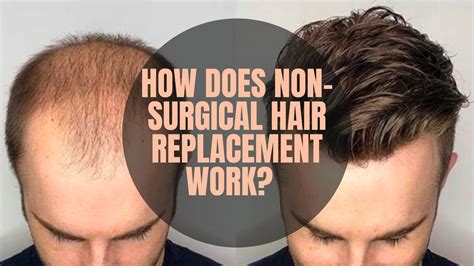Non-Surgical Hair Replacement: 10,000+ Ways to Regain Your Confidence
Why Non-Surgical Hair Replacement Matters?
Hair loss is a common problem affecting millions worldwide. It can significantly impact confidence and self-esteem. Non-surgical hair replacement offers a safe and effective solution to restore your natural appearance without surgery. With over 10,000 non-surgical hair replacement options available, there’s a perfect solution for every unique need.

Benefits of Non-Surgical Hair Replacement:
- Immediate Results: Non-surgical methods provide instant volume and coverage, transforming your appearance in a matter of hours.
- Customizable Solutions: These techniques can be tailored to your specific hair type, texture, and desired density, ensuring a natural-looking result.
- Non-Invasive: Unlike traditional hair transplants, non-surgical hair replacement methods are painless and do not require incisions or scarring.
- Affordable Options: Non-surgical hair replacement is available in a range of price points, making it accessible to individuals with varying budgets.
- Ultimate Flexibility: Many non-surgical methods allow for removal, allowing you to change your look as often as you wish without long-term commitment.
1. Hair Extensions: Connects natural or synthetic hair to existing strands, adding volume and length.
2. Toppers: Clip-on or lace-based devices that enhance the appearance of the crown or thinning areas.
3. Wigs: Full or partial hairpieces that conceal hair loss and provide a realistic look.
4. Scalp Micropigmentation: Creates the illusion of follicles with tiny tattoo dots, simulating a natural hairline.
5. Low-Level Laser Therapy: Stimulates hair growth by promoting blood circulation and nutrient delivery to the scalp.
6. Platelet-Rich Plasma (PRP) Therapy: Involves injecting concentrated platelets into the scalp to promote hair growth.
7. Minoxidil: Topical medication that slows hair loss and promotes growth in some individuals.
8. Finasteride: Oral medication that inhibits the production of DHT, a hormone that contributes to hair loss.
9. Hair Fibers: Electrostatically charged fibers that attach to existing strands, creating the appearance of thicker hair.
10. Headbands and Hair Accessories: Distract from hair loss and add style while camouflaging thinning areas.
- Alopecia Areata: Replaces lost patches of hair in autoimmune conditions.
- Scar Camouflage: Conceals scars caused by accidents, surgeries, or burns.
- Eyebrow and Eyelash Enhancement: Creates fuller and more defined facial features.
- Fashion and Creative Expression: Allows individuals to experiment with different styles without damaging their natural hair.
- Support for Cancer Patients: Provides temporary hair solutions during chemotherapy and other treatments.
Tips and Tricks for Success:
- Consult with a hair replacement specialist for a personalized assessment and recommendations.
- Choose a method that aligns with your lifestyle and maintenance preferences.
- Follow proper care instructions to maintain the longevity and health of your hair replacement system.
- Practice styling techniques to create a natural-looking result.
- Don’t let fear or stigma prevent you from exploring non-surgical hair replacement options.
FAQs:
1. How long does non-surgical hair replacement last?
The longevity varies depending on the method and care practices. Toppers and wigs may last several months to years, while laser therapy and PRP therapy require ongoing treatments.
2. Is non-surgical hair replacement expensive?
Options are available in a range of price points, from affordable hair fibers to more costly wigs and SMP.
3. Is non-surgical hair replacement detectable?
With proper application and selection, non-surgical hair replacement can appear natural and seamless.
4. Can non-surgical hair replacement damage my natural hair?
Proper maintenance and removal techniques minimize the risk of damage to natural hair.
5. What is the best non-surgical hair replacement option for me?
Consult with a hair replacement specialist for a customized assessment based on your unique needs.
6. Can I dye or style my non-surgical hair replacement?
Certain methods, such as extensions and toppers, can be dyed or styled with specific products.
7. Can I sleep in my non-surgical hair replacement?
Some methods, such as wigs and toppers, are not recommended for overnight wear, while others, such as hair fibers and headbands, can be worn comfortably overnight.
8. Can I exercise with non-surgical hair replacement?
Some methods are suitable for physical activity, while others may require additional care or removal before exercising.
Non-surgical hair replacement revolutionizes the way we address hair loss. With a wide range of options, personalized solutions, and transformative results, these methods empower individuals to regain their confidence and embrace their natural beauty. By leveraging non-surgical hair replacement, you can unlock the potential for a fuller, more vibrant appearance without the need for surgery.
